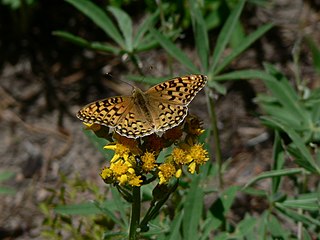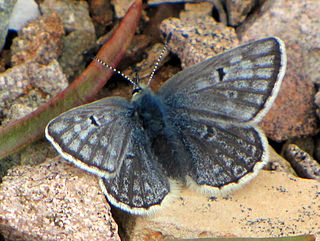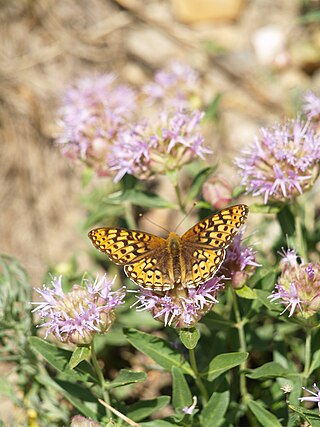
Pseudotsuga is a genus of evergreen coniferous trees in the family Pinaceae. Common names for species in the genus include Douglas fir, Douglas-fir, Douglas tree, Oregon pine and Bigcone spruce. Pseudotsuga menziesii is widespread in western North America and is an important source of timber. The number of species has long been debated, but two in western North America and two to four in eastern Asia are commonly acknowledged.

Abies concolor, the white fir, concolor fir, or Colorado fir, is a coniferous tree in the pine family Pinaceae. This tree is native to the mountains of western North America, including the Sierra Nevada and southern Rocky Mountains, and into the isolated mountain ranges of southern Arizona, New Mexico, and Northern Mexico. It naturally occurs at elevations between 900 and 3,400 metres.

Papilio multicaudata, the two-tailed swallowtail, is a species of the family Papilionidae found in western North America from British Columbia to Central America.

Speyeria zerene, the zerene fritillary, is a butterfly found in the western portions of the United States and Canada. The species was first described by William John Swainson in 1827.

Krüper's nuthatch is a species of bird in the family Sittidae. It is a small to medium-sized nuthatch, measuring 12.5 centimetres (4.9 in) in length. The upperparts are blue-gray, with the front half of the crown black in adults of both sexes, but with a less marked in the female rear. The species has a black or gray eyestripe and a prominent white supercilium. The underparts are blue-gray in males and buff-gray in females, with a large, crescent-shaped rufous pectoral patch. The Krüper's nuthatch feeds on insects in the summer and seeds, especially pines, in the fall and winter. Breeding takes place between March and May, and the nest is usually placed in a tree hole. The clutch consists of five to seven eggs, incubated by the female and fed by the male. Both parents take part in feeding the young.

Eldorado National Forest is a U.S. National Forest located in the central Sierra Nevada mountain range, in eastern California.

Plumas National Forest is a 1,146,000-acre (4,640 km2) United States National Forest located at the northern terminus of the Sierra Nevada, in northern California. The Forest was named after its primary watershed, the Rio de las Plumas, or Feather River.

Eacles imperialis, the imperial moth, is a member of the family Saturniidae and subfamily Ceratocampinae. It is found mainly in the East of South America and North America, from the center of Argentina to south Canada. The species was first described by Dru Drury in 1773.

The black arches or nun moth is a small Palaearctic moth. It is considered a forest pest.

Salmo-Priest Wilderness is a 41,335 acre (167.28 km2) wilderness area located in the Selkirk Mountains in the northeast corner of Washington state, within the Colville National Forest and the Kaniksu National Forest.

Spruce-pine-fir (SPF) is a classification of lumber that can be traded on commodities exchanges.

Agriades glandon, the Arctic blue or Glandon blue, is a species of butterfly in the family Lycaenidae. It in found in Eurasia and North America.

The California montane chaparral and woodlands is an ecoregion defined by the World Wildlife Fund, spanning 7,900 square miles (20,000 km2) of mountains in the Transverse Ranges, Peninsular Ranges, and Coast Ranges of southern and central California. The ecoregion is part of the larger California chaparral and woodlands ecoregion, and belongs to the Mediterranean forests, woodlands, and scrub biome.

Papilio indra, the Indra swallowtail, short-tailed black swallowtail, or cliff swallowtail, is a western North American butterfly in the family Papilionidae.

The Alberta–British Columbia foothills forests are a temperate coniferous forests ecoregion of Western Canada, as defined by the World Wildlife Fund (WWF) categorization system. This ecoregion borders Canada's taiga and contains a mix of subarctic forest and temperate forest species as a result. This makes the region an ecotone region, or a region that acts as a buffer between two other biomes.

The ecology of the Rocky Mountains is diverse due to the effects of a variety of environmental factors. The Rocky Mountains are the major mountain range in western North America, running from the far north of British Columbia in Canada to New Mexico in the southwestern United States, climbing from the Great Plains at or below 1,800 feet (550 m) to peaks of over 14,000 feet (4,300 m). Temperature and rainfall varies greatly also and thus the Rockies are home to a mixture of habitats including the alpine, subalpine and boreal habitats of the Northern Rocky Mountains in British Columbia and Alberta, the coniferous forests of Montana and Idaho, the wetlands and prairie where the Rockies meet the plains, a different mix of conifers on the Yellowstone Plateau in Wyoming, the montane forests of Utah, and in the high Rockies of Colorado and New Mexico, and finally the alpine tundra of the highest elevations.

The North Central Rockies forests is a temperate coniferous forest ecoregion of Canada and the United States. This region overlaps in large part with the North American inland temperate rainforest and gets more rain on average than the South Central Rockies forests and is notable for containing the only inland populations of many species from the Pacific coast.

Neophasia terlooii, the Chiricahua white,Chiricahua pine white, or Mexican pine white is a butterfly in the family Pieridae. It is found in New Mexico, in the high mountains of Arizona, and south into Mexico. The habitat consists of forests of needled conifers - Family Pinaceae.

Speyeria egleis, commonly known as the Great Basin fritillary or egleis fritillary, is a butterfly of the family Nymphalidae. It is found in the United States, where it has been recorded from North Dakota southwest through Oregon to California and south to Colorado. The habitat consists of mountain meadows, forest openings and exposed rocky ridges.

Euphilotes enoptes, the dotted blue, is a species of blue (Polyommatinae) butterfly in the family Lycaenidae. It is found in North America.




















